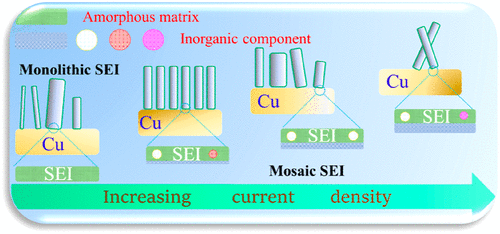Our official English website, www.x-mol.net, welcomes your
feedback! (Note: you will need to create a separate account there.)
Current Density Regulated Atomic to Nanoscale Process on Li Deposition and Solid Electrolyte Interphase Revealed by Cryogenic Transmission Electron Microscopy.
ACS Nano ( IF 15.8 ) Pub Date : 2020-06-29 , DOI: 10.1021/acsnano.0c03344 Yaobin Xu 1 , Haiping Wu 2 , Hao Jia 2 , Ji-Guang Zhang 2 , Wu Xu 2 , Chongmin Wang 1
ACS Nano ( IF 15.8 ) Pub Date : 2020-06-29 , DOI: 10.1021/acsnano.0c03344 Yaobin Xu 1 , Haiping Wu 2 , Hao Jia 2 , Ji-Guang Zhang 2 , Wu Xu 2 , Chongmin Wang 1
Affiliation

|
Current density has been perceived to play a critical rule in controlling Li deposition morphology and solid electrolyte interphase (SEI). However, the atomic level mechanism of the effect of current density on Li deposition and the SEI remains unclear. Here based on cryogenic transmission electron microscopy (TEM) imaging combined with energy dispersive X-ray spectroscopy (EDS) and electron energy loss spectroscopy (EELS) electronic structure analyses, we reveal the atomic level correlation of Li deposition morphology and SEI with current density. We discover that increasing current density leads to increased overpotential for Li nucleation and growth, leading to the transition from growth-limited to nucleation-limited mode for Li dendrites. Independent of current density, the electrochemically deposited Li metal (EDLi) exhibits crystalline whisker-like morphology. The SEI formed at low current density (0.1 mA cm–2) is monolithic amorphous; while, a current density of above 2 mA cm–2 leads to a mosaic structured SEI, featuring an amorphous matrix with Li2O and LiF dispersoids, and the thickness of the SEI increases with the increase of current density. Specifically, the Li2O particles are spatially located at the top surface of the SEI, while LiF is spatially adjacent to the Li–SEI interface. These results offer possible ways of regulating crucial microstructural and chemical features of EDLi and SEI through altering deposit conditions and consequently direct correlation with battery performance.
中文翻译:

低温透射电子显微镜揭示的锂沉积和固体电解质相间电流密度调节至纳米过程。
电流密度已被认为在控制Li沉积形态和固体电解质中间相(SEI)中起着关键的作用。然而,电流密度对Li沉积和SEI影响的原子级机理仍不清楚。在此基础上,通过低温透射电子显微镜(TEM)成像,能量色散X射线光谱(EDS)和电子能量损失谱(EELS)电子结构分析,我们揭示了Li沉积形态和SEI与电流密度的原子级相关性。我们发现,增加电流密度会导致Li成核和生长的过电位增加,从而导致Li树突从生长受限模式过渡到成核受限模式。与电流密度无关,电化学沉积的锂金属(EDLi)表现出晶须状晶形。低电流密度(0.1 mA cm–2)为整体非晶;而当电流密度大于2 mA cm –2时,会形成镶嵌结构的SEI,其特征在于具有Li 2 O和LiF弥散体的非晶态基质,并且SEI的厚度随电流密度的增加而增加。具体来说,Li 2 O粒子在空间上位于SEI的上表面,而LiF在空间上邻近Li-SEI界面。这些结果提供了可能的方法,通过改变沉积条件,从而调节EDLi和SEI的关键微结构和化学特征,从而与电池性能直接相关。
更新日期:2020-07-28
中文翻译:

低温透射电子显微镜揭示的锂沉积和固体电解质相间电流密度调节至纳米过程。
电流密度已被认为在控制Li沉积形态和固体电解质中间相(SEI)中起着关键的作用。然而,电流密度对Li沉积和SEI影响的原子级机理仍不清楚。在此基础上,通过低温透射电子显微镜(TEM)成像,能量色散X射线光谱(EDS)和电子能量损失谱(EELS)电子结构分析,我们揭示了Li沉积形态和SEI与电流密度的原子级相关性。我们发现,增加电流密度会导致Li成核和生长的过电位增加,从而导致Li树突从生长受限模式过渡到成核受限模式。与电流密度无关,电化学沉积的锂金属(EDLi)表现出晶须状晶形。低电流密度(0.1 mA cm–2)为整体非晶;而当电流密度大于2 mA cm –2时,会形成镶嵌结构的SEI,其特征在于具有Li 2 O和LiF弥散体的非晶态基质,并且SEI的厚度随电流密度的增加而增加。具体来说,Li 2 O粒子在空间上位于SEI的上表面,而LiF在空间上邻近Li-SEI界面。这些结果提供了可能的方法,通过改变沉积条件,从而调节EDLi和SEI的关键微结构和化学特征,从而与电池性能直接相关。











































 京公网安备 11010802027423号
京公网安备 11010802027423号